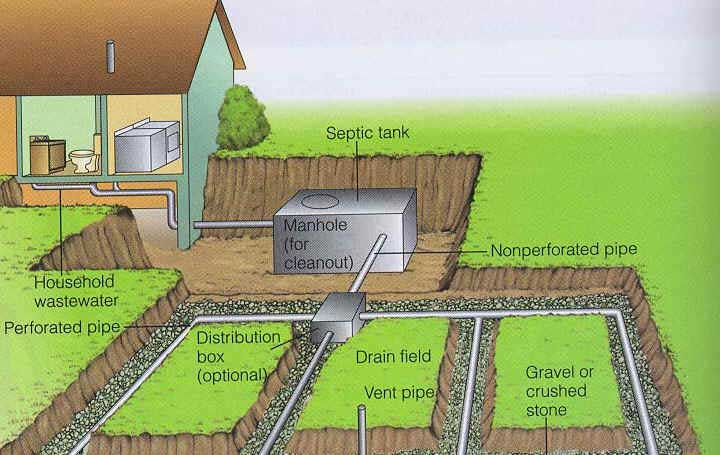Septic Tank Parts
 |
The biomat (biological mat) is a black, jelly-like mat that forms along the bottom
and sidewalls of the drainfield trench. It is composed of anaerobic
microorganisms (and their by-products) that anchor themselves to septic tank parts soil and rock
particles. Their food is the organic matter in the septic tank effluent. Since
the biomat has a low permeability, it slows down the rate of flow out of the
trench into the drainfield soil and also serves as a filter to provide effluent
treatment. With a well-developed biomat, wastewater maybe temporarily ponded
in the drainfield trench, yet the soil a few inches outside the trench will be
unsaturated.
|
The biomat forms first along the trench bottom and then up along trench walls. It has less permeability than fresh soil, so incoming effluent will pond over the biomat and trickle along the trench bottom to an area where there is little or no biomat; eventually the biomat will line the bottom of the trench and form up along the walls as well.
Through filtration and biological activity, the biomat is very effective at removing viruses and, in fact, filters out pathogenic bacteria and parasites.
In the trench, in a saturated environment, the anaerobic organisms in the biomat feed on the organic material in the wastewater; this causes the biomat to grow thicker and decreases permeability. On the soil side of the biomat, in an unsaturated environment, aerobic soil bacteria feed on and break down the biomat. In ideal conditions, these two processes go on at the same time, so the thickness and permeability of the biomat stay fairly consistent. Beautiful!
Since the biomat is alive, its equilibrium can be upset. Failure to regularly pump out the septic tank can result in an excess of organic material (food) to the biomat organisms, causing excessive growth and, therefore, reduced permeability In saturated soils, aerobic conditions no longer exist, and controlled breakdown of the biomat by aerobic soil bacteria will not occur.
If the septic system is poorly maintained, too much wastewater is flushed down the drain, or the drainfield soil remains saturated, the biomat eventually will grow too thick and dense, and the effluent sent to the drainfield will exceed the amount that can filter through the biomat. This can result in excessive ponding in the trenches, backflow into the septic tank (and possibly also into the house), or surfacing of effluent above ground over the drainfield—in other words "failure."
MAINTAINING A STABLE BIOMAT
Recent studies have shown that it is important to distribute the waste as evenly as possible along the entire infiltration zone. In many older systems, the pipe size is too large and the waste only flows a short way along the drainfield trench, dumping most of the effluent at the beginning of the trench, and none further along. When this occurs, the beginning of the trench eventually forms too thick a biomat of bacteria and other microorganisms, and plugs up. The flow then proceeds further down the trench until that segment plugs up. When the whole system becomes plugged, the drainfield fails. Dosed-flow drainfields (see pp. 87-89) can solve this problem. However, even in gravity-flow drainfields, with the right type soil, piping, and media for good distribution (as well as periodic pumping of solids from the tank), the biomat builds up to a stable layer, and the drainfield can go on treating the waste almost indefinitely.2766 Half and Half Drive, O Neals, CA | 559-868-7014 |